Related Research Articles
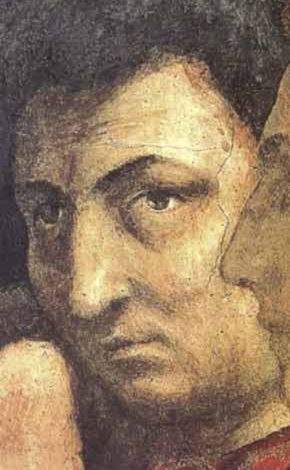
Masaccio, born Tommaso di Ser Giovanni di Simone, was a Florentine artist who is regarded as the first great Italian painter of the Quattrocento period of the Italian Renaissance. According to Vasari, Masaccio was the best painter of his generation because of his skill at imitating nature, recreating lifelike figures and movements as well as a convincing sense of three-dimensionality. He employed nudes and foreshortenings in his figures. This had seldom been done before him.
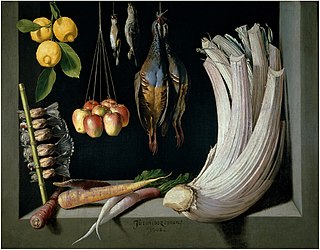
A still life is a work of art depicting mostly inanimate subject matter, typically commonplace objects which are either natural or human-made.

The Holy Trinity, with the Virgin and Saint John and donors is a fresco by the Italian Renaissance artist Masaccio in the Dominican church of Santa Maria Novella, in Florence. The fresco was among Masaccio's last major commissions and is often cited as one of the first monumental Renaissance paintings to utilize linear perspective.
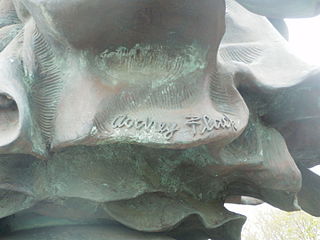
Audrey Flack is an American artist. Her work pioneered the art genre of photorealism and encompasses painting, printmaking, sculpture, and photography.

Nicolaes van Verendael or Nicolaes van Veerendael was a Flemish painter active in Antwerp who is mainly known for his flower paintings and vanitas still lifes. He was a frequent collaborator of other Antwerp artists to whose compositions he added the still life elements. He also painted a number of singeries, i.e., scenes with monkeys dressed and acting as humans.

Cornelis Norbertus Gijsbrechts or Gysbrechts was a Flemish painter who was active in the Spanish Netherlands, Germany, Denmark and Sweden in the second half of the seventeenth century. He was a court painter to the Danish royal family. He specialised in trompe-l'œil still lifes, an artistic genre which uses visual tricks to give viewers the illusion that they are not looking at a painting but rather at real three-dimensional objects. He also created many vanitas still lifes.

Hendrick Andriessen, known as Mancken Heyn was a Flemish still-life painter. He is known for his vanitas still lifes, which are made up of objects referencing the precariousness of life, and 'smoker' still lifes, which depict smoking utensils. The artist worked in Antwerp and likely also in the Dutch Republic.

The Marilyn Diptych (1962) is a silkscreen painting by American pop artist Andy Warhol depicting Marilyn Monroe. The monumental work is one of the artist's most noted of the movie star.
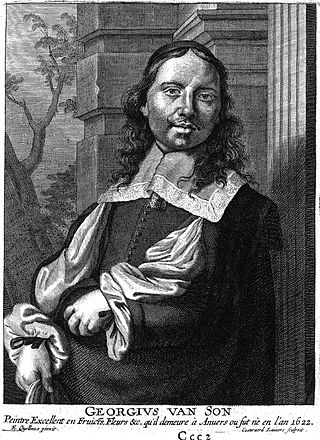
Joris van Son or Georg van Son was a Flemish still life painter who worked in a number of sub-genres but is principally known for his still lifes of fruit. He also painted flowers, banquets, vanitas still lifes and pronkstillevens. He is known to have painted fish still lifes representing the Four Elements, and also collaborated with figure artists on 'garland paintings', which typically represent a devotional image framed by a fruit or flower garland.

Cornelis van der Meulen or Cornelis Vermeulen, was a Dutch painter who after training in the Dutch Republic had a career in Sweden where he became a court painter. He is known for still lifes of flowers and game, trompe-l'œil and vanitas still lifes, topographical views and portraits.

Carstian Luyckx, also known as the Monogrammist KL, was a Flemish painter and draughtsman who specialized in still lifes in various subgenres including flower still lifes, fruit still lifes, fish still lifes, pronkstillevens, vanitas still lifes, hunting pieces and garland paintings. He also painted animals and a few genre scenes. After starting his career in Antwerp he is believed to have worked later in France.

Jan Pauwel Gillemans the Elder was a Flemish goldsmith and still life painter who is known for his fruit still lifes, flower pieces, vanitas still lifes and pronkstillevens.

Franciscus Gijsbrechts, was a Flemish painter of still lifes specialised in vanitas still lifes and trompe-l'œil paintings. He worked in the second half of the seventeenth century in the Spanish Netherlands, Denmark and the Dutch Republic. Like his father, he painted trompe-l'œil still lifes, a still life genre that uses illusionistic means to create the appearance that the painted, two-dimensional composition is actually a three-dimensional, real object.
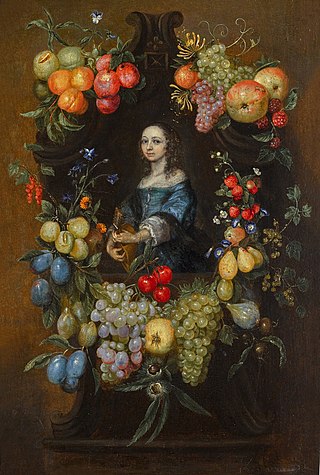
Catarina Ykens or Catarina Ykens (I) (née Floquet) (1608/1618 – after 1666) was a Flemish still life painter. She is known for flower and fruit garland paintings and vanitas paintings.

Frans van Everbroeck was a Flemish still life painter who is known for his fruit still lifes, vanitas still lifes and pronkstillevens. He was active in Antwerp, Amsterdam and London. The Dutch painters Abraham Mignon and Maria van Oosterwyck are regarded as his followers.

Godfriedt van Bochoutt (fl 1659–1666 was a Flemish still painter who was active in his native Bruges and Rotterdam. The limited body of work attributed to him ranges from fruit still lifes, hunting still lifes, vanitas still lifes and trompe l'oeil paintings.

Carel Fonteyn or Carel Fontyn was a Flemish painter active in Antwerp. He is known for his Vanitas still lifes with flowers, skulls and other Vanitas symbols.

Pseudo-Roestraten or Pseudo-Roestraeten is the notname given to an artist or artists to whom or which are attributed a number of vanitas still lifes likely created in the period between 1675 and 1725. The notname was given as the artist's works show some resemblance to that of the Dutch painter Pieter Gerritsz van Roestraten. Recurring elements of the paintings are arrangements of books, documents and precious objects with a vanitas meaning displayed on oriental carpets. The artist(s) may have been of German or Scandinavian origin. Many works of the anonymous artist are or were held in English collections, which makes it likely that the artist worked for some time in England.

Christian von Thum or Christian von Thum (I) (Kalmar, c. 1625 – Stockholm, 12 August 1686) was a Swedish innkeeper, still life painter, decorative painter, set painter, copyist and art agent. His known works include vanitas still lifes and still lifes with foodstuffs, paintings of hermits and religious paintings.
References
- Baskind, Samantha, "“Everybody Thought I Was Catholic: Audrey Flack’s Jewish Identity." American Art 23, no. 1 (2009): 104-15.
- Josephine Withers, "Monumental Still Lives." Feminist Studies 6, no. 3 (1980): 524-29.
- Fine, Elsa Honig, "One Point Perspective." Woman's Art Journal 15, no. 1 (1994): 2.
- Hauser, Katherine, "Audrey Flack's Still Lifes: Between Femininity and Feminism." Woman's Art Journal 22, no. 2 (2001): 26-1.
- Schlegel, Ursula. “Observations on Masaccio’s Trinity Fresco in Santa Maria Novella,” The Art Bulletin 45, no.1 (Mar., 1963): 19-33.
- Good, Kristi. “Marilyn Monroe.” Theatre History Studies 33 (1954): 209-225.